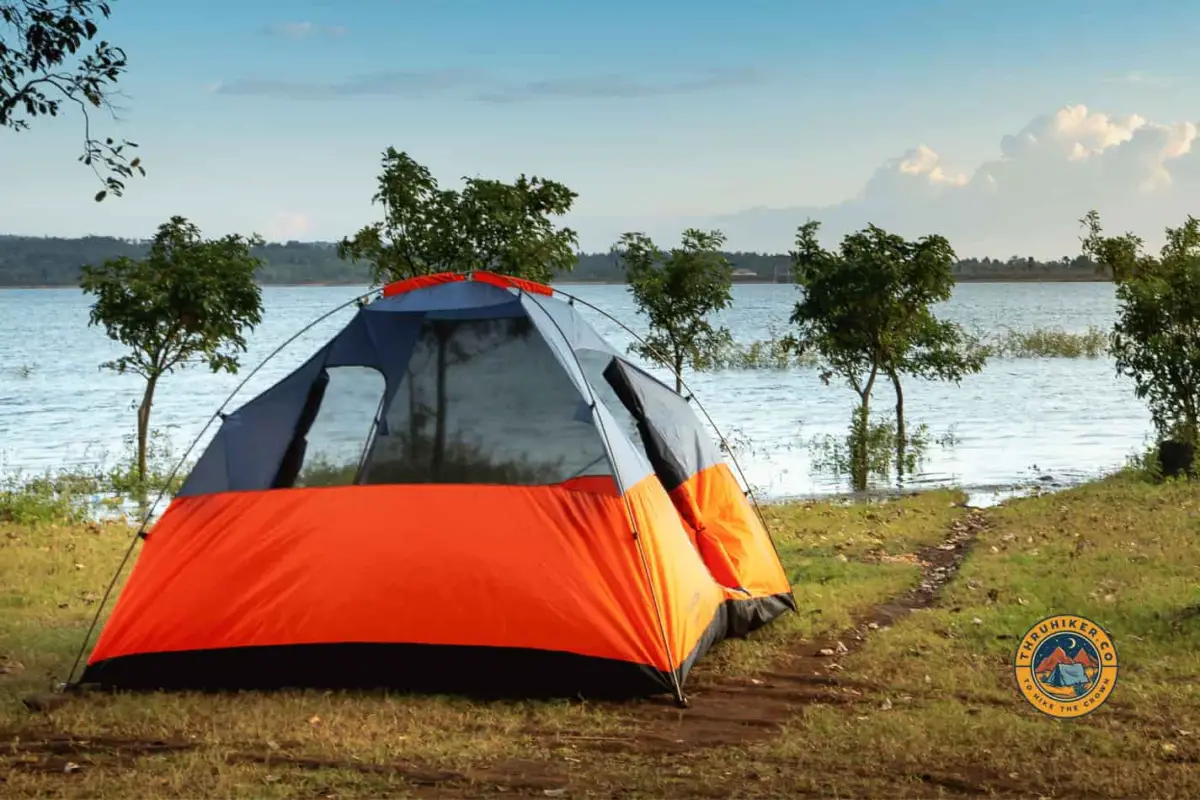Are you planning a thru-hike and looking for the perfect gear to make your journey as comfortable and successful as possible?
One of the most important decisions is deciding what shelter to use. Most thru-hikers will opt for trekking poles, semi-freestanding tents, or hammock systems instead of freestanding tents.
In this post, we’ll look at why hikers tend to avoid freestanding options in favor of lighter, more versatile setups.
From pitching to the time to set up, plus considerations about interior space and weight-saving potential – we’ll offer insight on when these lightweight alternatives might be preferable for your thru-hike.
Definition of a Freestanding Tent
A freestanding tent is a tent that can stand up by itself without needing to be staked out or tied down.
This is due to the tent poles, which fit into the four corners, providing the structure and support for the tent.
These tents are often heavier but easier to set up than others and can easily be moved around camp without losing shape.
Freestanding tents come in various styles and types, including single-wall and double-wall tents.
Types of Freestanding Tents
Regarding freestanding tents, there are two main body types; single-wall tent and double-wall. Both have their benefits and drawbacks.
Single-wall tents are lightweight and allow for better air circulation but are also more prone to condensation.
Double wall tents are heavier and slightly more expensive, but they offer superior weather protection and insulation from the elements.
Both types of freestanding tents can be excellent choices for camp, depending on the specific needs and preferences of the user.
Single Wall Tents
A single-wall tent is freestanding with only one layer of protective fabric. This type of tent is generally lighter and more affordable than double-wall tents, making them ideal for backpackers and hikers.
Single wall tents are also simpler to pitch and take down, making them great for those who want to spend less time setting up camp and more time exploring.
However, single-wall tents are typically not as durable as double-wall tents and are less than suitable for use in extreme weather conditions.
Double Wall Tents
Double wall tents are the most common type of freestanding tent and are typically the most popular.
They have an inner and outer layer that provides breathability and protection from the elements. They also come in various shapes and sizes to suit different needs.
The inner layer is usually breathable with windows and vents from materials like nylon or polyester. In contrast, the outer layer is usually made of waterproof materials like nylon or polyester coated with a waterproof coating.
They provide a good balance of breathability and protection from the elements; they are great for camp in hot and cold climates and backpacking trips.
Pros and Cons of Freestanding Tents for Long Treks
Freestanding tents offer a range of advantages, including ease of setup, portability, and stability.
Setting up a freestanding tent is usually much more straightforward than traditional tents as you don’t need to stake it out, making it an excellent option for those new to setting up a camp.
They are also significantly heavier and less portable than most hiking tents but can be easily moved around and repositioned while in camp.
Additionally, they tend to be more stable in general because they don’t need to be staked out to hold their shape.
However, there are some drawbacks to using a freestanding tent as they don’t need to be staked out, they can be more susceptible to strong winds, and can be moved around in windy conditions.
Additionally, they tend to be heavier than traditional hiking tents, requiring poles and other components to hold their shape.
Overall, freestanding tents offer a range of benefits, including easy setup, portability, and stability.
However, weighing the pros and cons before deciding if a freestanding tent is right for your trek is essential.
Choosing the Best Freestanding Tent for You
When choosing the right freestanding tent, there are several factors to consider; first and foremost, you need to decide on the size tent you need.
It’s important to have a tent that is big enough to comfortably fit the number of people that will be sleeping in it, for thru-hiking this would be one person or possibly two people most often.
You should also consider the amount of gear you will bring with you, the height, and other factors.
Additionally, you will want to consider the type of tent you need. Single-wall tents provide the lightest weight option but may not provide the same level of weather protection as a double-wall tent.
Next, you’ll want to consider the materials used in freestanding tents. Dyneema Composite Fabrics (DCF) is the lightest and most robust tent fabric available, but it is expensive.
Alternatively, SilNylon is lightweight and affordable, but it is not as strong as DCF and absorbs water over time.
Finally, you should consider the features of the tent. Does it have a vestibule? Is it easy to set up and take down? Does it come with a footprint, poles, or anything else you might need?
Once you’ve answered these questions, you’ll be well on your way to finding the perfect freestanding tent for your next outdoor adventure!
Pitching and Breaking Down a Freestanding Tent
Pitching a freestanding tent is straightforward; all you need to do is set up the poles and secure them in the corner grommets of the tent.
After that, the tent should be able to stand up on its own, and you won’t need to stake it down.
This makes freestanding tents perfect for those looking for a quick and easy setup, and the problem will be weight over time for most.
You can take your freestanding tent with you and move it around camp without worrying about staking it down again.
Sizing Your Freestanding Tent
When choosing a freestanding tent, the size is an important consideration. You’ll want to ensure that the tent is big enough to fit you and your gear comfortably.
This is especially true if you’re planning on camping with a significant other and splitting tent weight, as you’ll need a larger tent to accommodate you both with gear.
To ensure that you choose the right size tent, you’ll need to measure the space you need, so make sure to measure the length and width of the area you expect to fit the tent in.
Materials Used in Freestanding Tents
When selecting a freestanding tent, one of the most important factors is the type of material it is made from. Freestanding tents come in various materials, each with its benefits and drawbacks.
Two of the most popular materials used in freestanding tents are Dyneema Composite Fabrics (DCF) and SilNylon.
- Dyneema Composite Fabrics (DCF) are made from a combination of Dyneema fibers and a polyester film. This type of fabric is highly waterproof, lightweight, and strong. It is also very durable and can withstand high winds and heavy rains. However, it is also more expensive than other materials.
- SilNylon is made from nylon and silicone for waterproof and lightweight material. It is less expensive than DCF but not as durable or waterproof as DCF. It is also more prone to tears and punctures.
When selecting a freestanding tent, it is vital to consider the material it is made from, as different materials offer different benefits, which can make a big difference in the overall comfort and performance of the tent.
Ultimately, the best material for your tent will depend on the hike you plan on doing and the weather conditions you expect to encounter.
Dyneema Composite Fabrics
Regarding materials used in freestanding tents, Dyneema Composite Fabrics (DCF) are popular. DCF is a waterproof material made from Dyneema fibers and polyester.
This material is incredibly lightweight and robust, making it an ideal choice for freestanding tents.
DCF is also highly abrasion resistant, so it can withstand the wear and tear of being moved and used for six months or longer.
Additionally, DCF is known for its excellent waterproofing capabilities, meaning you don’t have to worry about tent leaks in wet weather.
SilNylon
SilNylon is a special nylon used to construct tents and many backpacking gears; it is highly resistant to tears and abrasions, making it an ideal material for tent fabric.
Additionally, SilNylon is very water-repellent when treated, lightweight, and breathable, which makes it an excellent choice for backpacking and hiking tents, as it offers the perfect balance of durability and comfort.
SilNylon also has a much longer lifespan than traditional nylon fabrics, making it a great option for those looking for a long-lasting tent.
Repairing Rips and Tears in Freestanding Tents
When it comes to repairing your freestanding tent, it’s important to know what type of material your tent is made out of.
Most freestanding tents are made of either DCF or SilNylon and both of these materials are highly durable, but each requires different repair methods.
For tents made of DCF, you will need to use specialized tape to repair any small holes or tears. This tape will be specially formulated to bond with the material, so you must purchase the correct type.
On the other hand, tents made of SilNylon can be repaired with special tape but with different base materials.
This tape is designed to adhere to the material and provide a strong and reliable patch. It’s important to note that you should not use regular tape or glue, as this could cause further damage to the tent.
It’s also important to check your tent regularly for any signs of wear and tear. While a freestanding tent is typically much more durable than a traditional tent, they still need to be maintained.
If you notice any areas that are starting to wear out, you should take preventative measures to ensure that the tent remains in good condition. This could mean resealing the seams or adding additional patches to strengthen weak spots.
Regularly inspecting and repairing your freestanding tent will help ensure that your tent remains in great condition for years to come.
Final Verdict: Are Freestanding Tents Practical for Thru-Hikes?
Freestanding tents are an ideal option for a newer hiker looking for a quick, easy setup option on a budget to get started with.
These tents balance cost, stability, and convenience, allowing you to set up and take down your tent quickly and easily.
They are available in various styles and sizes, meaning you can find the perfect tent to fit your needs.
When shopping for a freestanding tent, consider the size, weight, materials, and design to find the one that best suits your needs.
With the right tent, you can enjoy the convenience of a freestanding tent while still having a safe and comfortable place to sleep.


Leave a Comment